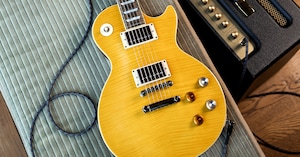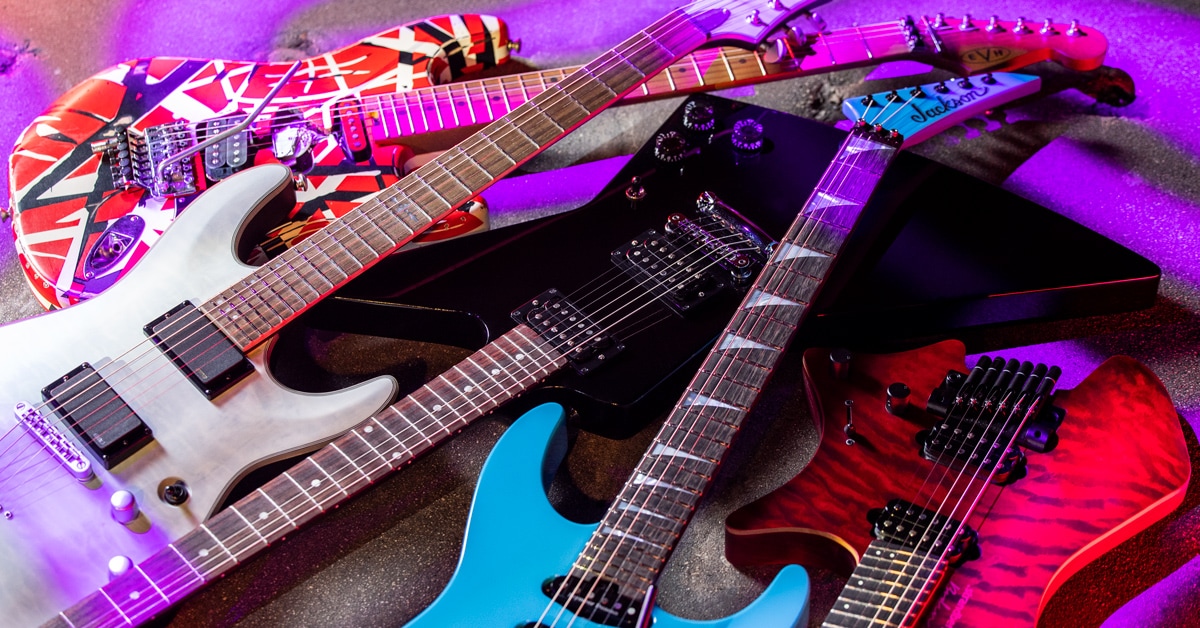The eruption was coming. As far back as Les Paul and Mary Ford’s 1951 hit, “How High the Moon,” guitar enthusiasts were treated to (for the time) lightning-fast sweeps of notes. Years later, classic rock virtuosos such as Jimi Hendrix, Ritchie Blackmore, Alvin Lee, Jimmy Page and others upped the ante for feverish spurts of speed on record, on stage, and, perhaps most importantly, on the pop charts.
Soon, an emerging community of players evolved rock guitar technique to the point of ferocious, mind-blowing intensity. They adopted and reengineered techniques such as sweep picking, tapping, hammer-ons, trills, arpeggios, tremolo-arm dive bombs and other actions to devise fluid, warp-speed solos, licks and riffs. It was an onslaught that captured the imagination of guitar fans, seriously challenged players and transformed popular music culture in the 1980s.
But these shredders needed new tools. Modded and hot-rodded. Their own machines. For the most part, the guitars loved by their parents and grandparents simply would not do precisely what the speed maestros wanted a guitar to do. It was time for a change.
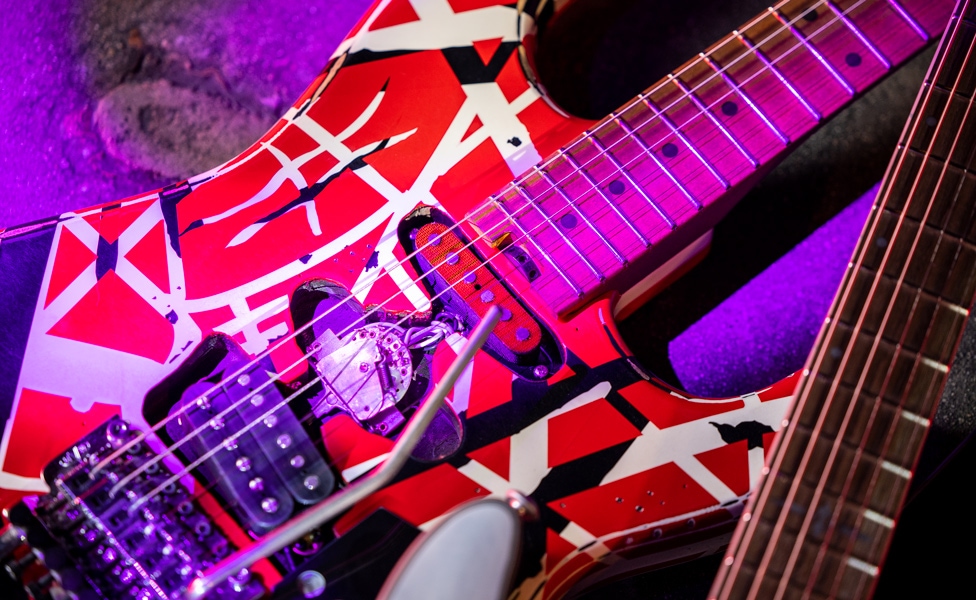
There’s the famous quote from Eddie Van Halen—published in the April 1980 issue of Guitar Player when he was just 23 years old—about the obsession with building his own instruments: “I’m just a punk kid trying to get a sound out of a guitar that I couldn’t buy off the rack.”
Well, Van Halen was an epic visionary, but to be fair, not all guitar makers were unaware of this burgeoning wave of extreme stylists and their performance requirements. Brands such as Charvel, Ibanez, ESP, Schecter, Kramer, Jackson, Dean, B.C. Rich and Carvin were answering the call, and building models that accommodated light-speed fretboard gymnastics.
What did these players want that was different from standard, “off the rack” guitars from Gretsch, Gibson, Fender, Epiphone and other manufacturers of the day? Well, let’s dig into the features that typically distinguish a shred-ready guitar, before you embark on your own search for the best guitar for metal.
Table of Contents
What Makes a Guitar a Metal Guitar?
Comparing the Best Metal Guitars
The Top Metal Guitars
Charvel Pro-Mod DK24
Epiphone Tony Iommi SG Special
Ernie Ball Music Man John Petrucci Majesty 6
ESP LTD James Hetfield Signature Iron Cross
ESP LTD Mick Thomson MT-I
EVH Striped Series Frankie
EVH Wolfgang Standard T.O.M.
Gibson ’80s Flying V
Ibanez JEMJR Steve Vai Signature
Ibanez Nita Strauss Signature JIVAJR
Ibanez RG6003FM
Ibanez TOD10 Tim Henson Signature
Jackson American Series Soloist SL3
Jackson American Series Soloist SL2MG
Jackson Pro Series Misha Mansoor Juggernaut HT7FM 7- String
Jackson Pro Plus Pure Metal Limited-Edition Kelly KE1A
Jackson X Series Rhoads RRX24
Schecter Guitar Research Synyster Custom-S Relic
Schecter Guitar Research Hellraiser C-1 FR
Wylde Audio Warhammer FR Norse Dragon Bullseye
.strandberg* Boden Standard NX 6 Tremolo
Unleash the Riffin’
What Makes a Guitar a Metal Guitar?
The not-so-hush-hush secret is that almost any guitar could be a metal guitar. A player’s technique, talent, creativity and preference for whatever instrument inspires them should be more important than adhering to trends or style concepts. For example, Billy Duffy of The Cult plays decidedly non-shred guitars from Gretsch, and one of the godfathers of metal—Tony Iommi—has stuck with old-school Gibson SGs since the first Black Sabbath album. So, while you shouldn’t rule out any models that may fit your personal approach to burning up the fretboard, there are reasons why so many uber-technical players gravitate to certain features and designs. Here’s a basic look-see at what those elements are.
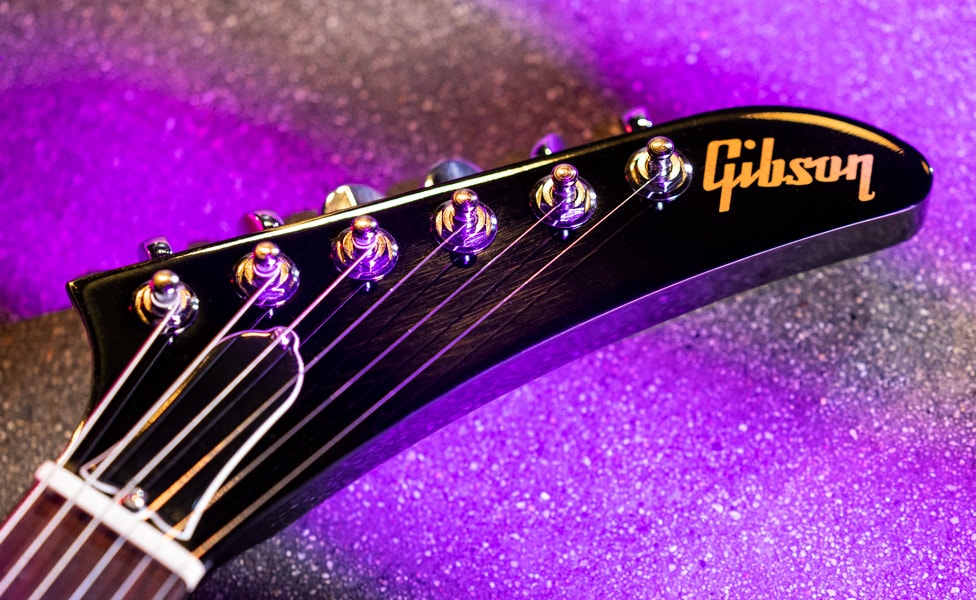
Pointy headstocks. In the 1980s, a pointy headstock was primarily a fashion—or product design—statement that usually characterized an aggressive metal guitar. The sharp tip did not provide a significant tonal advantage, it wasn’t a particularly new idea (check out Gibson’s 1958 Explorer for one example) and the phrase itself was sometimes used divisively to mock players in the shred, spandex and big hair crowd. But few headstocks projected such outright menace and danger as the spike topping a Charvel, Jackson, Ibanez or similar shred guitar. Other headstocks—even the Explorer’s “child safe” rounded point—would leave you defenseless during a zombie apocalypse. The “bayonet” on a Jackson, however, could hold off undead hordes for hours. How metal is that?
Frets and fret access. Many shredders prefer guitars with 24 frets, because—well, a few more notes. Duh. However, being able to zoom up to the sky-high, dweedly-dweedly frets is critical, and it’s not easy to get there unless you’re wielding a double-cutaway guitar with a comfy, sculpted neck heel. Any guitar built for speed should ensure there are no impediments that prevent your hand and fingers reaching the top notes from the low-E string all the way across to the high-E string. This is why shred-oriented guitars tend to join the neck to the body near or at the 24th fret, and promise “enhanced” or “easy” upper-fret access.
Low action. Most metal and shred guitars are set up with low actions, meaning the strings are positioned as close to the frets as possible without triggering fret buzz or any other sonic anomalies. A low action makes it almost effortless to zip around the fretboard—an obvious advantage for any player seeking to break speed records.
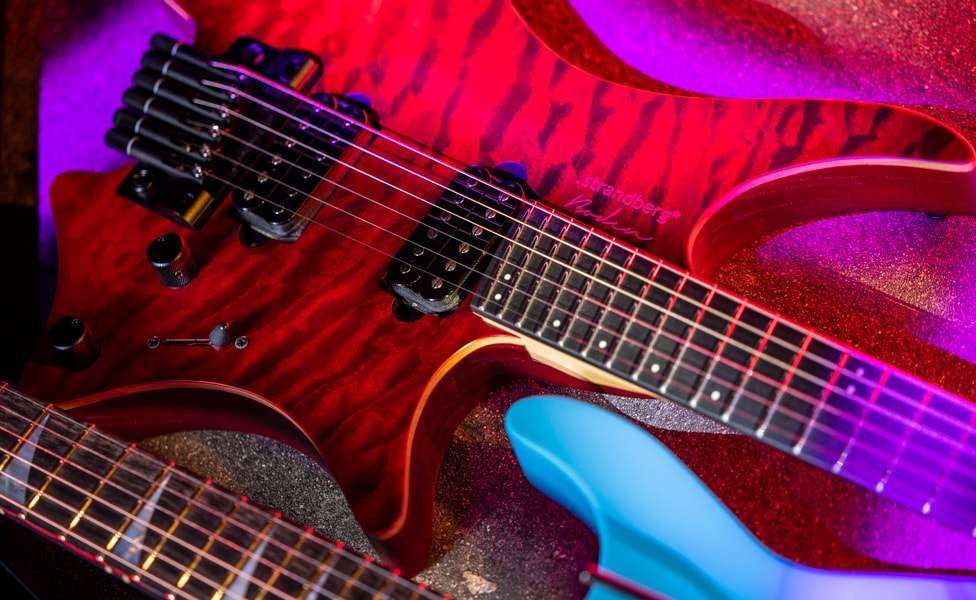
Scale length. A guitar neck with a long scale length—meaning the distance between the nut and the bridge—of at least 25.5" is the sweet spot for shredding. The longer the scale, the more tension imposed on the guitar strings, which provides two very nice benefits—you can set the action low without risking fret buzz, and you can use lighter string gauges (.009 or .008) that are easier to fret and bend.
Neck profile. If a guitar neck with substantial girth is typically the enemy of speed, then you don’t want a chunky, baseball bat-sized neck if you’re aspiring to emulate speedsters such as Michael Angelo Batio, Tosin Abasi or Nita Strauss. Guitars manufactured for metal players usually offer a C profile—as those necks are slim, slightly curved and are very comfortable to play—or a D profile, which is flatter than a C, and, for some players, provides a more satisfactory foundation for anchoring the thumb. Try each profile to see what works best for you. Unless you have big hands, prefer a challenge or dig subverting expectations, you should probably avoid bulky neck profiles such as U and V.
Fretboard radius. Every fretboard is curved, and the radius figure alerts you to the specific degree of curvature you’ll encounter while playing the guitar. For shredders, a fretboard radius of at least 15" is preferable, because the larger the number, the flatter the curve. A more even and level curvature is beneficial, as it accommodates a low action sans fret buzz and favors fleet fingers. By contrast, a lower fretboard radius of around 12" is more curved, and while that’s not necessarily a deal breaker, it’s a radius typically more suitable for chord work than blazing riffery. Some guitars let you have it both ways by providing a compound radius neck that changes the degree of curvature as a player works down the fretboard. You’ll most likely see a designation of 12" to 16", as it’s the most familiar compound radius neck.
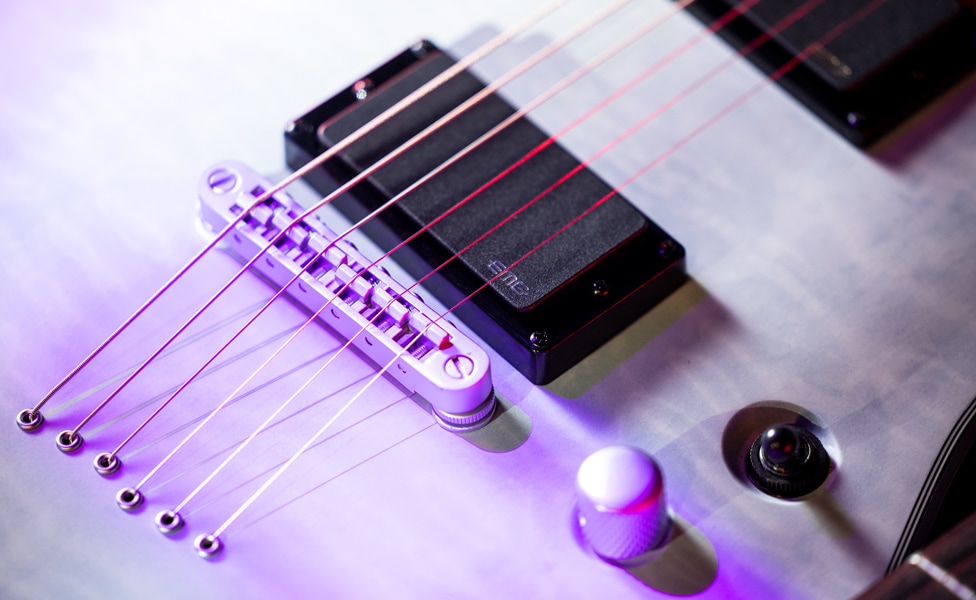
High-output or active pickups. A must. It would be extremely difficult to play metal with feeble pickups struggling to push an amp into delicious overdrive and creamy saturation. Replacement pickup pioneers such as Larry DiMarzio (recognized as the “originator” with his 1972 Super Distortion), Seymour Duncan and EMG’s Rob Turner aided and abetted the hard rock and metal crowd from the early ’70s onward. While DiMarzio and Duncan initially produced high-energy passive pickups—and all DiMarzio models remain passive to this day—Turner devised active designs that require a power source (typically a 9V battery) to produce gobs of gain, increased headroom and enhanced EQ. As both circuits—active and passive—deliver more roar, it comes down to which type of pickup generates the sound you want.
Tremolo system. It’s certainly not required that metal guitarists play tremolo-equipped instruments—Tony Iommi, who pretty much invented metal guitar, rarely uses a tremolo—but it’s super fun to have one at hand. Floating bridge systems, such as the original Fender design and Floyd Rose locking tremolos, let you vary pitches, perform “dive bombs,” incorporate stutters and swoops into solos, and transform conventional melodic passages into high drama.
Swagger. Like pointy headstocks, a guitar with “swagger” won’t improve your technique or tone, but a flamboyant finish may inspire you to rock like a hurricane. Since the ’80s, metal soloists have boosted their stage charisma by playing guitars emblazoned with neon colors, geometric designs, animal patterns, bold stripes, faux snake skins, vibrant crackle effects, exaggerated pinstripes and stickers of all types. While you can play just as fast on a guitar with a classy satin-black finish as you can on a model bearing garish purple-and-orange tiger stripes, elegance and sophistication may not elevate the awesome theater that is metal guitar. Just some food for thought …
Comparing the Best Metal Guitars
|
Model |
Body |
Neck |
Pickups |
Bridge |
Price* |
|
Alder |
Maple |
Seymour Duncan Custom Full Shred/Alnico II Pro humbuckers |
Gotoh 510 tremolo |
$999.99 |
|
|
Mahogany |
Mahogany |
Epiphone PRO P-90s |
Adjustable wraparound |
$799 |
|
|
Okoume |
Mahogany |
DiMarzio Dreamcatcher/Rainmaker humbuckers |
Custom John Petrucci Music Man floating tremolo |
$3,899 |
|
|
Mahogany |
Mahogany |
EMG James Hetfield humbuckers |
TonePros T.O.M. |
$1,599 |
|
|
Mahogany |
Maple |
Fishman Fluence Mick Thomson Signature humbuckers |
Hipshot High Mass fixed |
$1,599 |
|
|
Basswood |
Maple |
EVH Wolfgang humbucker |
Floyd Rose tremolo |
$1,999.99 |
|
|
Basswood |
Roasted maple |
EVH Wolfgang humbuckers |
EVH T.O.M. |
$599.99 |
|
|
Mahogany |
Mahogany |
’80s Tribute humbuckers |
Nashville Tune-O-Matic |
$2,499 |
|
|
Meranti |
Maple |
Quantum set (HSH) |
Double-locking floating tremolo |
$499.99 |
|
|
Meranti |
Maple |
Quantum set (HSH) |
Edge-Zero II floating tremolo |
$849.99 |
|
|
Mahogany |
Maple |
Quantum humbuckers |
Ibanez F106 fixed |
$349.99 |
|
|
Basswood |
Roasted maple |
Fishman Fluence Tim Henson Signature humbuckers |
Gotoh T1502 tremolo |
$1,499.99 |
|
|
Alder |
Maple |
Seymour Duncan JB TB-4 humbucker & Custom Flat Strat SSL-6 single coils |
Floyd Rose 1500 Series tremolo |
$2,349.99 |
|
|
Alder |
Maple |
EMG 81/85 humbuckers |
Floyd Rose 1500 Series tremolo |
$2,599.99 |
|
|
Basswood |
Roasted maple |
Jackson MM1 humbuckers |
Jackson HT7 string-through-body hardtail |
$949.99 |
|
|
Poplar |
Maple |
Fishman Fluence Modern humbucker |
Floyd Rose 1000 Series tremolo |
$1,399.99 |
|
|
Poplar |
Maple |
Seymour Duncan Blackout humbuckers |
Floyd Rose Special tremolo |
$899.99 |
|
|
Mahogany |
Mahogany |
Schecter USA Synyster Gates Signature & Sustainiac humbuckers |
Floyd Rose 1500 Series tremolo |
$1,999 |
|
|
Mahogany |
Mahogany |
EMG 81TW/89R humbuckers |
Floyd Rose 1000 Series tremolo |
$1,149 |
|
|
Mahogany |
Maple |
EMG 81/85 humbuckers |
Floyd Rose 1000 Series tremolo |
$1,799 |
|
|
Swamp ash |
Maple |
.strandberg* Custom OEM set (HSH) |
.strandberg* EGS Rev 7 tremolo |
$1,745 |
Pricing as of April 2025*
The Top Metal Guitars
Whether you’re a student seeking a nurturing and comfortable shred machine, or an experienced metal guitarist looking for a rocket ship to elevate your already formidable chops, we’ve curated the fastest, most popular, gig-proven and artist-approved collection of metal electric guitars to meet everyone’s needs. Let’s plug in …
Charvel Pro-Mod DK24
Why It’s Cool: Charvel’s Pro-Mod DK24 is a quintessential Superstrat for shred-oriented metalheads.
Things to Consider:
- Sleek, beveled output jack keeps your cable out of the way
- Series/parallel toggle switch for extra tonal dimension
- Gotoh 510 tremolo is a stable, lower-maintenance alternative to a floating system
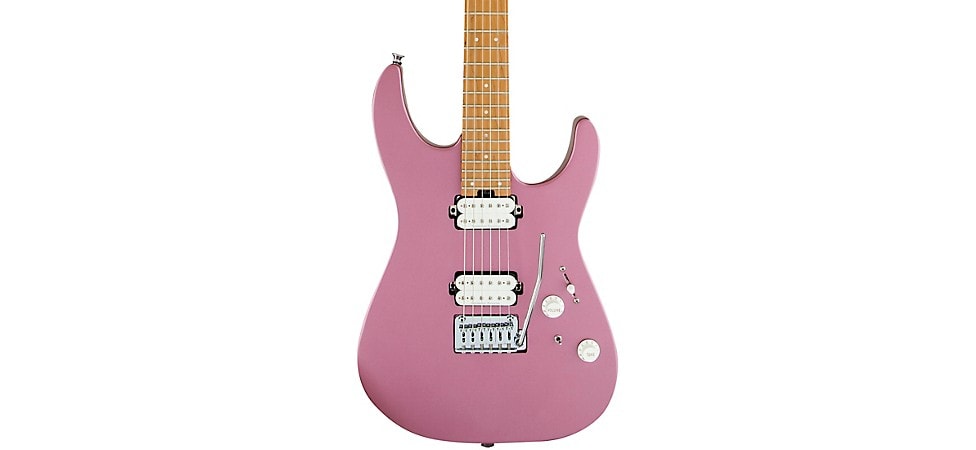
Shop Now: Charvel Pro-Mod DK24 HH 2PT CM Electric Guitar in Burgundy Mist
The metal roots of the Charvel Pro-Mod DK24 HH 2PT run as deep as the Mariana Trench. Founder Wayne Charvel and Grover Jackson (who bought the Charvel company in 1978) can quite convincingly be portrayed as the architects of modern, high-quality built-for-speed guitars. (Eddie Van Halen’s iconic “Frankenstein” guitar was made from parts supplied by Charvel.) The Pro-Mod DK24 struts the celebrated Charvel/Jackson Dinky body style, a scalloped lower bout for unfettered access to all 24 frets, a caramelized maple bolt-on neck and fingerboard, two Seymour Duncan humbuckers (a Custom Full Shred SH-10B bridge pickup and an Alnico II Pro APH-1N neck pickup), a Gotoh Custom 510 tremolo bridge and a choice of elegant finishes, such as Matte Blue Frost, Satin Burgundy Mist and Gloss Black.
Epiphone Tony Iommi SG Special
Why It’s Cool: The Epiphone Tony Iommi SG Special captures the look and feel of an axe that helped pioneer heavy metal.
Things to Consider:
- P-90s’ unique articulation works well for metal
- Rounded C-shaped neck plays like a vintage guitar
- 24.75" scale length warrants thicker strings for down tuning

Shop Now: Epiphone Tony Iommi SG Special Electric Guitar in Vintage Cherry
Interestingly, the godfather of metal did not conjure heavy metal guitar playing with a pointy headstock, a DIY project or even a tremolo bar. Tony Iommi gravitated to a Gibson SG—which Eric Clapton had used in the band Cream—for the recording of Black Sabbath’s first album in 1969, and he has been famously loyal to the model ever since. The Epiphone Tony Iommi SG Special is based on the original 1964 SG that birthed the sound of metal. Unlike typical shred guitars, the Tony Iommi SG Special features two P-90 pickups, 22 frets, a 24.75" scale length and a rounded neck, but its massive imprint on metal guitar cannot be argued or ignored.
Ernie Ball Music Man John Petrucci Majesty 6
Why It’s Cool: The Majesty 6 is the culmination of longtime EBMM artist John Petrucci’s tireless pursuit of the perfectly playable guitar for progressive rock and metal.
Things to Consider:
- In-line control placement for ergonomic accessibility
- Incredibly sleek with a distinctly modern look and feel
- Crafted in San Luis Obispo, California

Shop Now: Ernie Ball Music Man John Petrucci Majesty 6 Electric Guitar in Wisteria Blossom
Ernie Man Music Man John Petrucci Majesty series guitars come in a dizzying number of drool-worthy wood and finish options, as well as 6-string, 7-string and 8-string configurations. We’ll focus on the Dream Theater fretboard wizard’s Ernie Ball Music Man John Petrucci Majesty 6, which offers comfy body contours, access to all 24 medium-jumbo frets, Petrucci’s signature DiMarzio Dreamcatcher and Rainmaker humbuckers, Fishman Powerbridge piezo saddles, a 20dB boost, coil tapping and mono or stereo output. Playing the Majesty 6 is like riding a champion thoroughbred stallion to victory at Churchill Downs, and, similarly, the price to compete can be rich. Happily, amongst the wide range of Majesty offerings are more affordable models, such as the Sterling by Music Man Majesty. Pro Tip: You can really zero in on nailing the Petrucci vibe by pairing the Majesty 6 with his signature MESA/Boogie amp, the JP-2C.
ESP LTD James Hetfield Signature Iron Cross
Why It’s Cool: You can dial in your down-picking technique with Metallica frontman James Hetfield’s iconic Iron Cross signature from LTD.
Things to Consider:
- Upper-bout pickup toggle is unwired and replaced by a second switch
- 24.75" scale length warrants thicker strings for down tuning
- Rugged gig bag is included
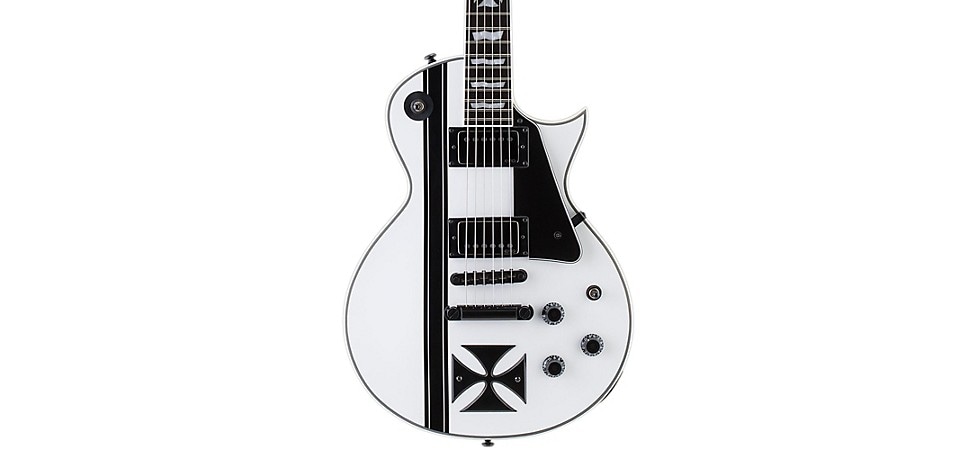
Shop Now: ESP LTD James Hetfield Signature Iron Cross Electric Guitar in Snow White
Metallica’s James Hetfield is far more renowned as a rhythm player than a barnstorming soloist, so his ESP LTD James Hetfield Signature Iron Cross is designed to favor mammoth riffs and thick, powerful chords. The thin U-shaped profile is thicker than most shredders go for, but it’s a great neck for really digging into ferocious licks. There’s unhindered access to all 22 frets—just in case you do want to blast out some note flurries—and an EMG JH Signature set of active pickups ensures your tone is ballsy as all hell.
ESP LTD Mick Thomson MT-I
Why It’s Cool: The LTD Mick Thomson MT-I is a no-nonsense metal monster conjuring massive Slipknot-style tones and beyond.
Things to Consider:
- Push/pull volume and three-way switch select Fishman Fluence voices
- Locking Gotoh strap buttons for onstage security
- Includes an ESP form-fit hardshell case

Shop Now: ESP LTD Mick Thomson MT-I Electric Guitar in Obsidian Metallic
Mick Thomson’s signature MT-I electric from LTD brings never-before-seen features to the brand’s popular MH platform. Designed to the Slipknot axeman’s specs, the guitar is outfitted with Hipshot Grip-Lock tuners, a Hipshot High Mass hardtail bridge, a Graph Tech Black TUSQ XL nut, blue Luminlay side dots and, of course, one Fishman Fluence Mick Thomson Signature bridge humbucker. A smooth ebony fretboard with a 12"–16" compound radius facilitates fast fretboard movement, and the thin U-shaped profile fits comfortably in your hand. Aesthetically, the MT-I incorporates a sports car-esque Obsidian Metallic finish that’s both understated and devilishly brooding.
EVH Striped Series Frankie
Why It’s Cool: Channel the unchained aura of one of hard rock and metal’s most influential DIY designs with the EVH Striped Series Frankie.
Things to Consider:
- Onboard D-Tuna quickly takes you from standard to drop-D tuning and back
- Neck is spec’d to Eddie Van Halen’s modified C shape
- Relic’d finish offers the worn-in, road-weathered aesthetic of the original
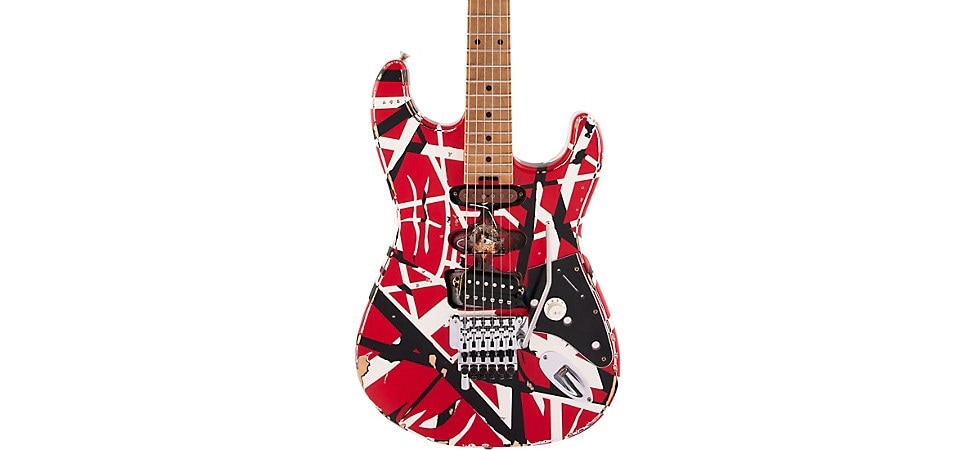
Shop Now: EVH Striped Series Frankie Electric Guitar in White with Black and Red Stripes Relic
The EVH Striped Series Frankie pays homage to one of Eddie Van Halen’s legendary DIY builds—the “Frankie” or “Frankenstrat”—that forged a massive cultural insurrection regarding the guitar platforms scores of metal players choose to create their music. The EVH Striped Series Frankie emulates the battered, carved-out and duct-taped body of the original “workshop” guitar that Van Halen constantly tinkered with, and it includes one EVH Wolfgang humbucker, an EVH-branded Floyd Rose locking tremolo and the EVH D-Tuna. Of course, Eddie Van Halen continued to explore guitar design and tone, and his EVH company offers models from his 5150 to the Wolfgang Special, and even left-handed Stripes and Wolfgangs.
If you're intrigued by the EVH Frankie, check out our Deeper Dive Into the Superstrat to get the full story.
EVH Wolfgang Standard T.O.M.
Why It’s Cool: Signature EVH style and sound lie at the core of the Wolfgang Standard T.O.M.—all at a friendly price for beginners, intermediates and veterans shopping for a go-to workhorse.
Things to Consider:
- Basswood body with special “comfort cut” forearm contour
- Features a fixed bridge and stoptail bar for the first time
- Direct-mounted EVH Wolfgang humbuckers deliver throaty high-gain tones

Shop Now: EVH Wolfgang Standard T.O.M. Electric Guitar in Cream White
The EVH Wolfgang Standard T.O.M. electric may be a “budget” guitar, but it boasts a bevy of top-tier appointments, like a 12"–16" compound-radius baked maple neck. Heat-treated maple is regarded for its resistance to temperature and humidity fluctuations, and EVH shores it up further with graphite reinforcement rods to lock in its road-ready reliability. Besides, you can always make ad-hoc truss rod adjustments conveniently from the easy-access spoke wheel at the base of the neck. The Wolfgang Standard T.O.M. also incorporates a fixed bridge for those who prefer stability and sustain to daredevil dive bombs.
Gibson ’80s Flying V
Why It’s Cool: Based on sought-after vintage models from 1984, the Gibson ’80s Flying V harkens back to a pivotal era in metal history.
Things to Consider:
- ’80s Tribute pickups produce the thick, rich hard rock tones of the day
- 24.75" scale length warrants thicker strings for down tuning
- Hardshell case included
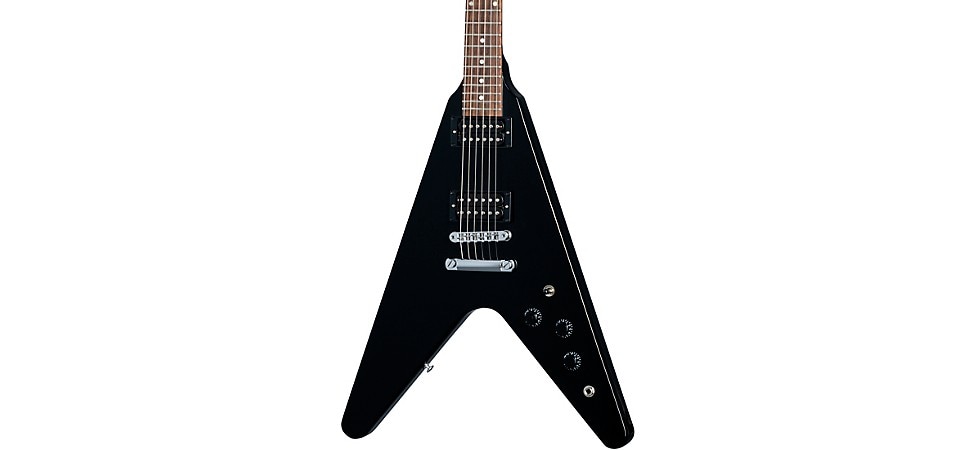
Shop Now: Gibson '80s Flying V Electric Guitar in Ebony
Made in 1958, the Gibson Flying V could have been considered a guitar from mom and dad’s generation by shredders looking for something new and exciting. However, the Flying V’s futuristic and iconic body spoke boldly to some exceptional ’80s metal players (Randy Rhoads, anyone?), and also inspired slight rethinks of the design by other manufacturers. The Gibson ’80s Flying V is based on the company’s 1984 model that was launched to appeal to metal players of the day. The Gibson SlimTaper neck is shred ready, and the Gibson ’80s Tribute pickups capture the roar of the MTV era. Another eminent design from Gibson’s space-age class of 1958—which was also prized and co-opted by metal players and guitar makers during the Ronald Reagan presidency—is the Gibson ’80s Explorer. Fans of mid-century modern trends should also check out the many other Gibson Flying V and Explorer models, and more affordable options are available, such as the Epiphone Flying V and Epiphone Explorer.
Ibanez JEMJR Steve Vai Signature
Why It’s Cool: Steve Vai’s signature JEM was a breakthrough for Ibanez in 1987, and the JEMJR is an accessible way to experience its lasting legacy.
Things to Consider:
- Meranti body offers balanced frequency response
- Tonally versatile HSH pickup configuration
- Sturdy double-locking floating vibrato system
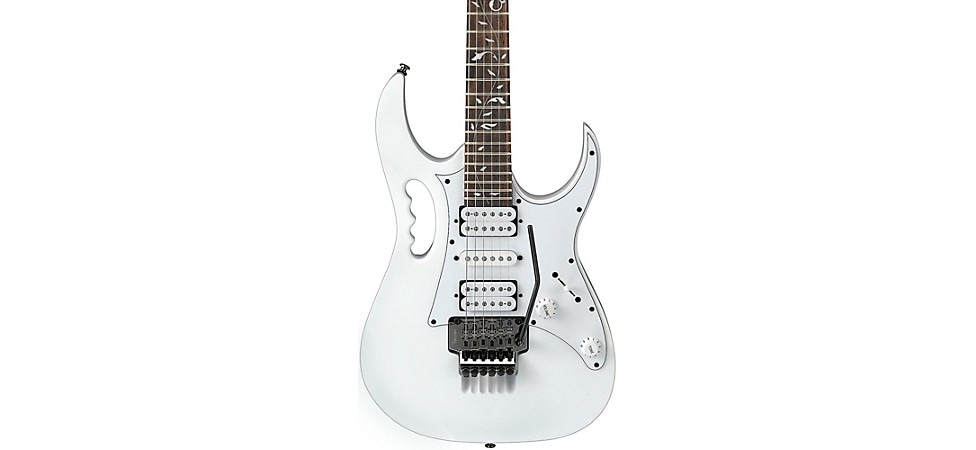
Shop Now: Ibanez JEMJR Steve Vai Signature JEM in White
The affordable Ibanez JEMJR Steve Vai Signature makes the transcendent guitarist and composer’s distinctive and immediately recognizable instrument available to more players. The JEM’s distinguishing characteristics are present and accounted for—the Monkey grip, Tree of Life inlay and Lion’s Claw tremolo cavity—as well as shred-approved features, such as a 15.75" fretboard radius, a 25.5" scale length, an HSH pickup configuration, access to all 24 frets and a thin, flat Wizard III neck. If you’d prefer to go "upscale Vai," check out the Ibanez JEM77P or Ibanez PIA3761 Steve Vai Signature.
To learn even more about the Ibanez JEM, check out A Guide to the Ibanez JEM.
Ibanez Nita Strauss Signature JIVAJR
Why It’s Cool: Nita Strauss’ signature Ibanez JIVAJR is an artist model with universal appeal to guitar players who love a combination of cool aesthetics and elite performance.
Things to Consider:
- More affordable version of the JIVA10 model released in 2018
- Attention-grabbing Deep Sea Blonde finish on quilted maple
- Luminescent side dot inlays for low-light fretboard navigation

Shop Now: Ibanez Nita Strauss Signature JIVAJR Electric Guitar in Deep Sea Blonde
After joining Alice Cooper’s band in 2014, the hurricane that is Nita Strauss has captivated rock audiences and blown the minds of guitarists—ultimately becoming Ibanez’s first female signature artist and the featured player for Guitar Center’s 2019 Guitar-A-Thon. The Ibanez Nita Strauss Signature JIVAJR electric builds upon the S Series foundation—touted for its razor-thin body and molded contours—with modifications to suit her own preferences. The JIVAJR contains a trio of Quantum pickups in an HSH layout, a low-profile Zero-Edge II floating vibrato system and a sleek ebony fretboard adorned with Strauss’ signature Beaten Path inlay.
For more of Ibanez's top metal-leaning axes, be sure to check out The Best Ibanez Guitars for Metal.
Ibanez RG6003FM
Why It’s Cool: Exclusive to Guitar Center, the Ibanez RG6003FM features premium specs at an entry-level price.
Things to Consider:
- Eye-catching flamed maple top
- Fixed bridge makes string swaps and tuning changes easier for beginners
- Mahogany body produces low-mid warmth for full-bodied riffs

Shop Now: Ibanez RG6003FM Electric Guitar
For three decades, the high-performance Ibanez RG has inspired metal players to achieve greater heights of speed, as well as elevate their riff, lick and song composition. The Ibanez RG6003FM brings on the same flat, thin Wizard III neck used for the Steve Vai and Nita Strauss signature models, but struts its own Ibanez Quantum humbuckers and a fixed bridge.
Ibanez TOD10 Tim Henson Signature
Why It’s Cool: The Ibanez TOD10 ignites Tim Henson’s signature fretboard fireworks and provides a colorful tonal palette for everyone to explore.
Things to Consider:
- Push/pull tone knob toggles Fishman Fluence voicings
- Luminescent side dot inlays for dimly lit stages and studios
- Stainless steel frets are virtually impervious to wear
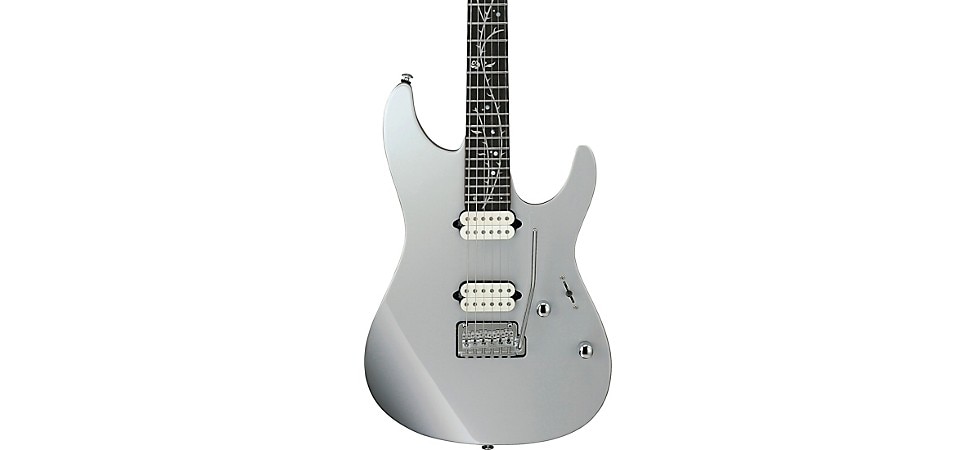
Shop Now: Ibanez TOD10 Tim Henson Electric Guitar in Classic Silver
Based on an Ibanez AZ model, the Ibanez TOD10 Tim Henson Signature celebrates the Polyphia guitarist with a collaborative design that features his signature Fishman Fluence pickups, a 25.5" scale length, a Gotoh T1502 tremolo bridge and an Oval-C neck shape. Further personalizing his signature model, Henson opted to add thorns to Ibanez’s iconic Tree of Life fretboard inlay, calling it the "Tree of Death."
Jackson American Series Soloist SL3
Why It’s Cool: Hard rockers will appreciate the Jackson Soloist SL3’s keen attention to high-performance detail.
Things to Consider:
- Through-body neck construction enhances sustain
- Rolled fretboard edges for additional comfort and speed
- HSS pickup configuration covers lots of tonal ground
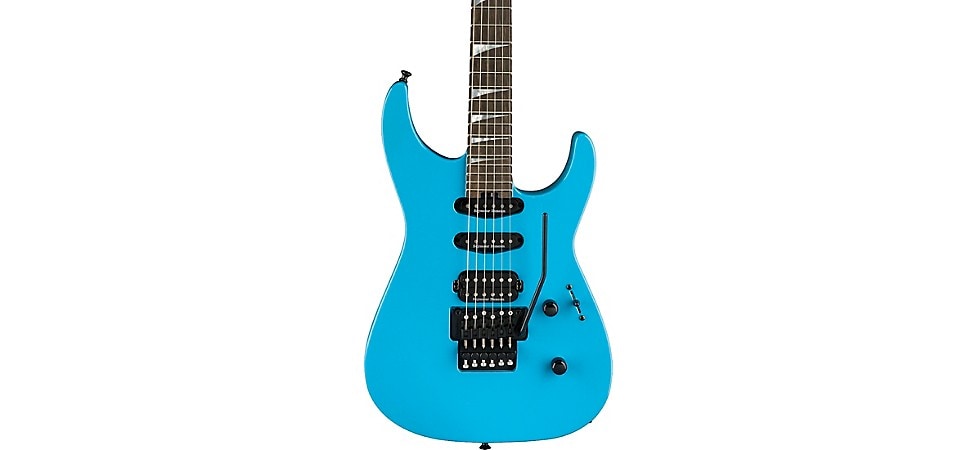
Shop Now: Jackson American Series Soloist SL3 Electric Guitar in Riviera Blue
Grover Jackson is one of the most influential and important designers of high-performance guitars, and the Jackson American Series Soloist SL3 is not only the first American-built Jackson model for many years, it also carries the pedigree of the company’s decades-long commitment to producing tools for extreme-velocity players. The Soloist SL3 instigates maximum speed and sonic mayhem with a 12"–16" compound radius fretboard, a 25.5" scale length, 24 frets, a Floyd Rose 1500 double-locking tremolo and Seymour Duncan pickups.
Jackson American Series Soloist SL2MG
Why It’s Cool: The American Series Soloist SL2MG by Jackson is an extreme metal dream built for all-out sonic onslaughts.
Things to Consider:
- Active pickups provide the output and articulation integral to modern metal tones
- Equipped with Gotoh MG-T locking tuners
- Jackson Foam-Core case is included
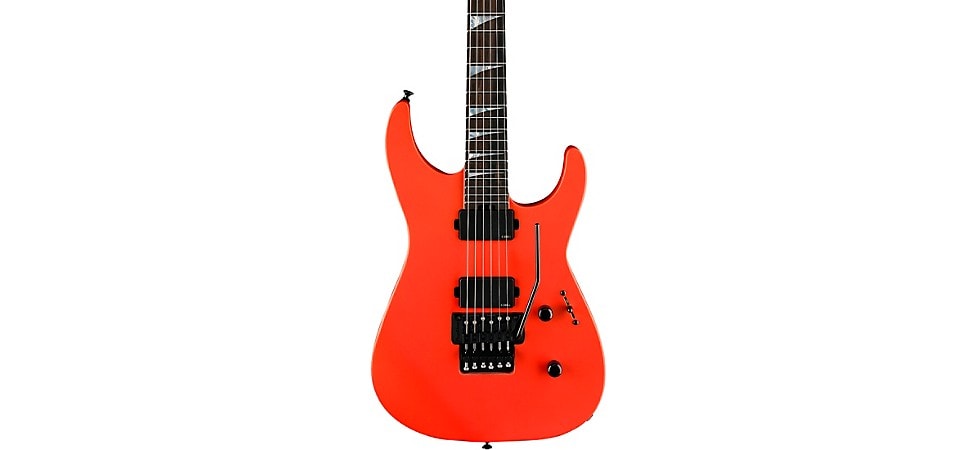
Shop Now: Jackson American Series Soloist SL2MG Electric Guitar in Satin Lambo Orange
The Jackson Soloist has been a hard rock and metal mainstay for over 40 years. Superior playability is an inherent quality of this Superstrat, available in both floating Floyd and hardtail Hipshot versions—the American Series Soloist SL2MG and SL2MG HT, respectively. A razor-sharp headstock and shark fin inlays are an aesthetic giveaway that this machine is engineered for elite performance, and EMG 81/85 pickups certify the notion. Jackson tops it off with stainless steel frets and a compound 12"–16" fretboard radius assisting smooth bends, easy chording and white-hot lead lines.
Jackson Pro Series Misha Mansoor Juggernaut HT7FM 7-Stringx
Why It’s Cool: Misha Mansoor’s signature Jackson Juggernaut HT7FM is a 7-string powerhouse for progressive metal players.
Things to Consider:
- Factory strung with Horizon Devices Progression Tension Standard 7 strings
- Custom MM1 pickups voiced for precise attack and clear articulation
- Roasted maple neck/fretboard with rolled edges
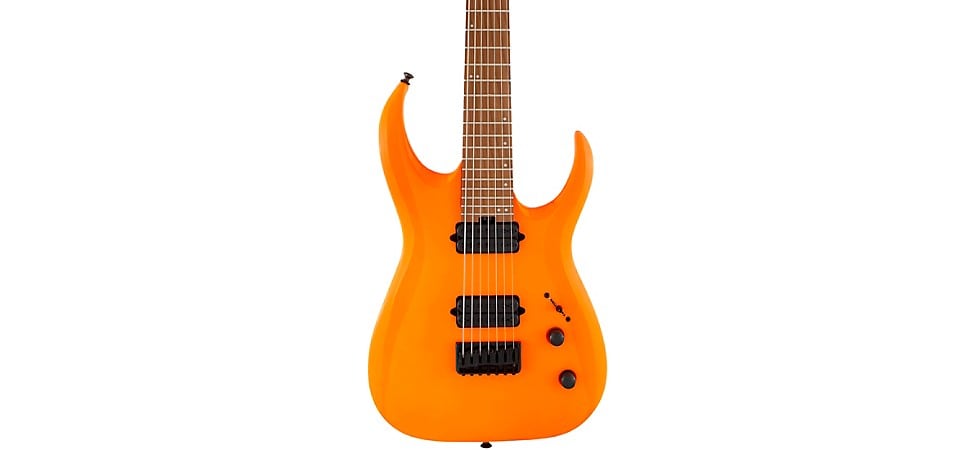
Shop Now: Jackson Pro Series Misha Mansoor Juggernaut HT7FM 7-String Electric Guitar in Neon Orange
Co-designed with Periphery speed demon Misha Mansoor, the Jackson Pro Series Misha Mansoor Juggernaut HT7FM 7-String is an aptly named metal machine. Every element of the Juggernaut is built for high-velocity 7-string workouts, from the comfy wrap-around heel to the 16" flat radius fretboard, 26.5" scale length, 24 jumbo frets, string-through-body hardtail bridge and explosive Jackson MM1 pickups. In addition, Mansoor and Jackson offer a collection of 6-string and 7-string models at various price points, such as the affordable Jackson Pro Series Juggernaut HT6 and the ultraluxe Jackson USA Signature Juggernaut HT6FM. For the full-on Misha Mansoor experience, match your Juggernaut of choice with the amp head he designed with Peavey—an invective MH Mini or invective.120.
Jackson Pro Plus Pure Metal Limited-Edition Kelly KE1A
Why It’s Cool: The Jackson Pro Plus Pure Metal limited-edition Kelly KE1A puts a spin on a classic, enduring shape originally conceived in the early ’80s.
Things to Consider:
- All-black finish with creme binding
- Hallmark Jackson neck-through-body construction
- Push/pull volume control activates Fishman Fluence Modern voices

Shop Now: Jackson Pro Plus Pure Metal Kelly KE1A Limited-Edition Electric Guitar in Gloss Black
The Jackson Kelly body style—inspired by the Gibson Explorer with evident modifications—was designed by Bradford Kelly of Australian heavy metal band Heaven and handed to Grover Jackson to build. It was introduced in 1983, and has been in production, in various iterations, since. The Jackson Pro Plus Pure Metal limited-edition Kelly KE1A electric has formidable stage presence with its void-like, glossy black finish, highlighted by chrome hardware, pearloid sharkfin inlays and vintage-inspired creme binding. It features a 12"–16" compound-radius ebony fretboard, 24 jumbo stainless steel frets and a single Fishman Fluence Modern bridge humbucker. The limited-edition Kelly KE1A is a serious shredder’s guitar that’s confidently badass and unexpectedly classy.
Jackson X Series Rhoads RRX24
Why It’s Cool: Originally commissioned from Jackson by the legendary Randy Rhoads, the RRX24 is a performance-oriented shred machine with an aggressive silhouette.
Things to Consider:
- Through-body maple neck enhances sustain
- Recessed Floyd Rose vibrato bridge for underhand comfort
- Active Seymour Duncan humbuckers offer searing output
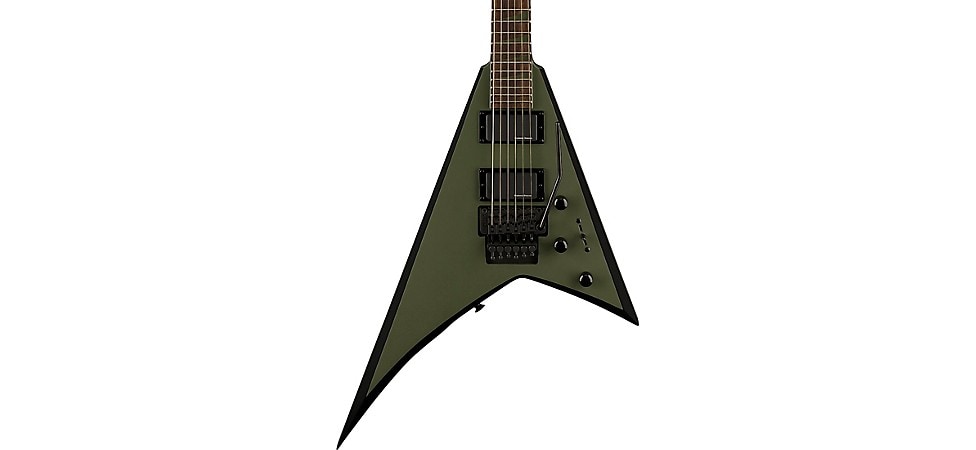
Shop Now: Jackson X Series Rhoads RRX24 Electric Guitar in Army Drab with Black Bevels
An otherworldly alliance of guitarist Randy Rhoads, designer Grover Jackson and his team, and inspiration from the original Gibson Flying V created one of the most distinctive and thrilling metal guitars of the shred era. (Of course, it didn’t hurt that a brilliant player such as Rhoads was rocking it.) The Jackson X Series Rhoads RRX24 continues to hold Rhoads’ design DNA in its soul, and at an affordable price. The RRX24 includes a 12"–16" compound radius fretboard, 24 jumbo frets, a 25.5" scale length and two active Seymour Duncan Blackout pickups.
Schecter Guitar Research Synyster Custom-S Relic
Why It’s Cool: The Schecter Synyster Custom-S Relic satisfies Avenged Sevenfold fans with signature appointments from the iconic lead guitarist.
Things to Consider:
- Bridge pickup cover etched with Synyster Gates’ logo
- Incredibly thin C-shaped neck profile for smooth maneuverability
- Gold pearloid SYN and Deathbat fretboard inlays
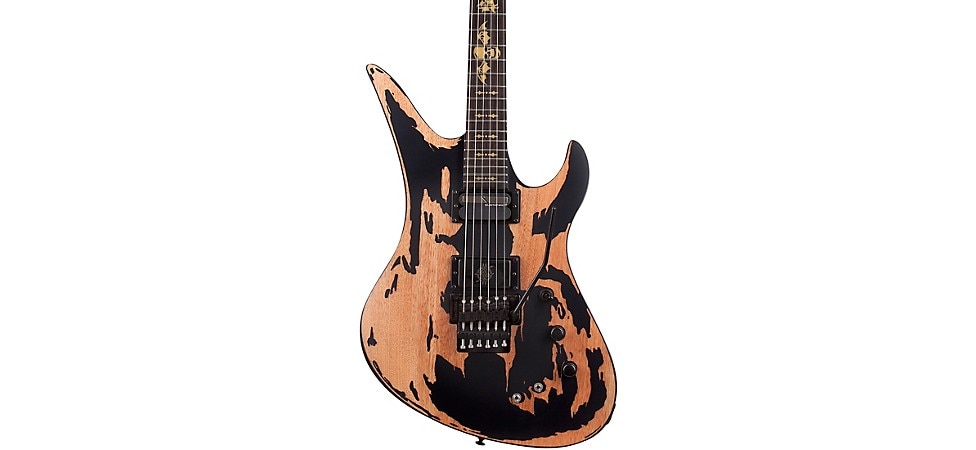
Shop Now: Schecter Guitar Research Synyster Custom-S Relic in Distressed Satin Black
A7X riff maestro Synyster Gates is a longstanding Schecter devotee who’s had a signature Custom-S shred stick with the metal-centric brand for years. Rocking a brash road-worn look for the first time, the Schecter Synyster Custom-S Relic is “a little piece of heaven” for those who favor its aggressive body shape, Floyd Rose tremolo system, Sustainiac neck pickup and one-of-a-kind Deathbat inlay. Its beaten relic finish is illustrative of over two decades of contemporary metal stewardship, and seemingly a nod to Synyster Gates’ ongoing, unbreakable legacy as a multi-platinum guitar talent.
For a look at more of Schecter's metal axes, check out The Best Schecter Guitars for Metal.
Schecter Guitar Research Hellraiser C-1 FR
Why It’s Cool: The Schecter Guitar Research Hellraiser C-1 FR’s shred-ready playability and rock-solid dependability have made it a player-favorite workhorse for years.
Things to Consider:
- Two push/pull volume knobs, one tone control and a three-way blade
- Easy-playing, thin C-shaped neck
- Opulent abalone Gothic Cross inlays
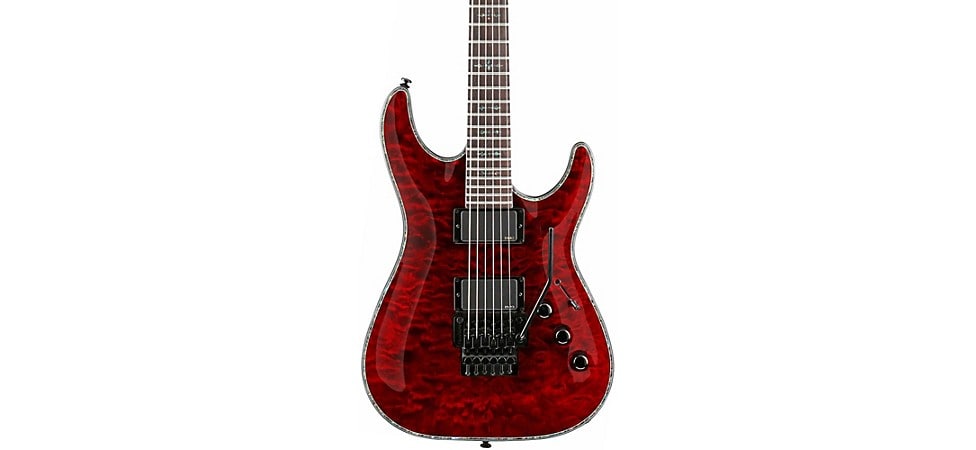
Shop Now: Schecter Guitar Research Hellraiser C-1 FR in Black Cherry
The Schecter Guitar Research Hellraiser C-1 FR is definitely designed to evoke the infernos of hades—as least as far as ferocious metal guitar playing is concerned—with a 25.5" scale neck, 24 extra-jumbo frets, a Floyd Rose 1000 Series tremolo system, and active EMG 81TW and EMG 89 pickups.
Wylde Audio Warhammer FR Norse Dragon Bullseye
Why It’s Cool: Players with a take-no-prisoners attitude to high-gain riffage will relish the bold, brash aesthetic of the Wylde Audio Warhammer.
Things to Consider:
- Independent pickup volume and master tone controls
- Classic hard rock/metal tone via EMG active pickups
- 22 extra-jumbo frets
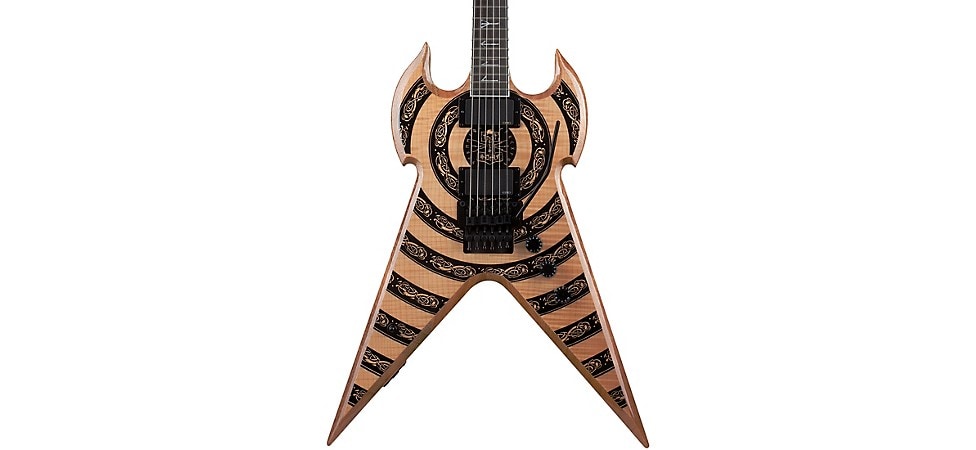
Shop Now: Wylde Audio Warhammer FR Norse Dragon Bullseye in Rawtop
Smithed by the metal-savvy luthiers at Schecter, Zakk Wylde’s Wylde Audio line of axes has been deliberately honed for shredders looking to embark on a blessed hellride into victory or Valhalla. While it’s not a “signature” model in the traditional sense, the double-cutaway Wylde Audio Warhammer is built to the Black Label Society/Ozzy virtuoso’s exacting specs. From Viking-inspired aesthetic appointments like white pearloid “runes” inlays and a flamed maple top featuring a Norse Dragon graphic to EMG 81/85 pickups and a Zakk “C” neck with a 14" fingerboard radius, it’s the ideal tool for your sweeps, pinch harmonics and earth-rumbling chugging riffs alike. Fire up your sonic brew with Warhammer, or let either of its Wylde Audio Norse Dragon Bullseye siblings—Nomad or Barbarian—set you free.
.strandberg* Boden Standard NX 6 Tremolo
Why It’s Cool: The Boden Standard NX 6 Tremolo by the boundary-pushing masterminds at .strandberg* inspires intrepid guitarists to blaze new sonic trails by way of supreme ergonomics.
Things to Consider:
- Patented EndurNeck has squared edges to promote a loose, relaxed grip
- Lightweight headless design for comfort as well as portability
- Basswood body with deep arm and torso carves
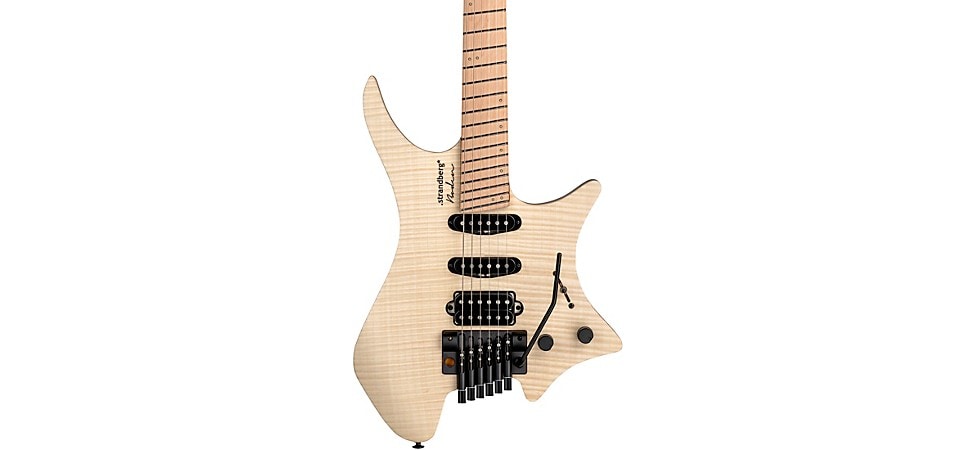
Shop Now: .strandberg* Boden Standard NX 6 Tremolo Electric Guitar in Neutral
Much like metal guitarists and shred-devoted guitarmakers disrupted the guitar scene in the 1980s, .strandberg*’s adventurous, headless designs have started a bit of a wave with YouTube sensations (Plini), female shredders (Sarah Longfield) and even some old-school virtuosos (Mike Keneally). The .strandberg* Boden Standard NX 6 Tremolo is a modern, eye-catching design that is as comfortable to play as it is visually striking. The Boden Standard NX 6 features a 20" fretboard radius, 24 medium-jumbo fanned frets, an HSS pickup configuration and a .strandberg* EGS Rev 7 tremolo. These guitars appear to delight iconoclasts of all styles, as well as modern prog players, math rock disciples, fusion fiends, metal heads and more. Not surprisingly, the Strandberg line includes 6-string, 7-string and 8-string variations. Check them all out. Furthermore, as headless guitars in general appear to be reemerging, take a peek at models from Ibanez, Steinberger, Traveler, Legator and other makers.
Unleash the Riffin’
From old-school but still-viable shred machines to ’80s-approved guitars built for virtuosos and velocity to radical new designs, there are an incredible number of choices available to today’s metal players. And some models offer even more flexibility by providing 6-string, 7-string and 8-string versions. All of this means that no metal player should ever need to get as frustrated with “off the rack” guitars as Eddie Van Halen was back in the late 1970s.
No matter how you play, or how you like to sound, there is a guitar right now that’s calling your name. We hope this list helps you find it. On that note, be sure to check our Used Guitars section, as you might discover an ’80s ESP George Lynch Signature Tiger, a “cult classic” Fender HM Strat or a very pointy B.C. Warlock just waiting to be yours.
If you're in the market to upgrade your rig, read through our recommendations for the Best Guitar Amps for Metal.



